 Hello,
Good Buy Hello,
Good Buy
PRABHAT AWASTHI 34
Vice
President & Senior Analyst, J.P. Morgan
SECTORS:
Telecommunication,
Automotive
For Prabhat Awasthi, getting it wrong
a few times isn't such a big deal-as long as he's getting it right
most of the times. "Consistency and humility are most important.
If one has made a wrong call, one should be able to muster the courage
to change it. On the other hand, you also need to have the conviction
to stick to your belief. Even if the whole world is screaming "sell"
and you're convinced of a buy, you should stand by your belief,"
points out the Vice President & Senior Analyst at J.P. Morgan
India.
For the past nine years as an analyst, at such broking houses
as SSKI, J.M. Morgan Stanley and, for the past three and half years,
at J.P. Morgan, you could safely conclude that Awasthi has been
getting it right fairly consistently. His favourite call is his
recommendation at the time of the initial public offering of Bharti
Tele. Having put a buy at Rs 34, Awasthi watched the stock plummet
to Rs 20 after hitting a high of Rs 45. But Awasthi remained bullish
and in fact changed his call from neutral to overweight. Today,
the Bharti stock is trading at around Rs 160. Yet, Awasthi is aware
of the pressure put on analysts to make the right call every time.
"How is that possible when even the companies often themselves
aren't aware of how things will pan out?" smiles the soft-spoken
engineer, who makes it a point to meet (telecom) vendors and (auto)
dealers to corroborate management-talk. Awasthi's dose of wisdom
to budding analysts: "Don't get carried away by stock momentum.
Once you've reached your target, call it a day."
-Brian Carvalho
 The
Hobbyist The
Hobbyist
MANISH SAXENA 34
Assistant
Vice-President, ICICI Securities
SECTORS:
Cement,
Engineering, Metals
Early 2003, the SARS threat was holding
the world hostage, and most analysts were bearish on steel. Manish
Saxena wasn't. That may have something to do with his beginnings
in the steel industry, something that he believes helps him understand
the infrastructure sector better. Or it could be the analytic approach
of the electrical engineer from VJTI, Mumbai, who also holds a post-graduate
degree from the Institute of Chartered Financial Analysts of India
(ICFAI). "Ethical management, long-term strategy of the management,
the enthusiasm displayed by the management, systems, risk management,
and transparency" are some of the things Saxena considers while
analysing a company. His best recommendations: Tata Steel three
years ago (Rs 70) and last year again (Rs 160, and the stock trades
at Rs 380 today); L&T (Rs 200 and the stock trades at Rs 600
today); and BHEL last year (at Rs 160 and the stock trades at Rs
600 today). And while tracking stocks may be his vocation, understanding
the market is his hobby.
-Shilpa Nayak
Calling
The Right Numbers
MANISH SRIVASTAVA
34
Assistant
Director & Co-head (Asian Telecom Research), ABN Amro
SECTORS:
Telecommunications
He may be based in Singapore but
you are likely to spot Manish Srivastava at New Delhi's Ghaffar
Market, India's biggest grey market for new phones and most happening
market for second-hand ones, or in Jakarta's shopping malls. These
visits help the IIM-A alum figure out the dynamics of the used-phone
market. The second-hand market, reasons Srivastava, drives the telecommunication
services business. And so, the man who has covered sectors as diverse
as media, cement, banking, and automotive for brokerages such as
CLSA and SSKI, and who shifted to Singapore in the second half of
2003 doesn't visit the offices of telcos as often as he once used
to even as he tracks seven large companies in the region. You see,
Ghaffar Market holds the key!
-Roshni Jayakar
 An
Egghead On
The Street An
Egghead On
The Street
C. VISALAKSHI 34
Senior
Analyst, Kotak Securities
SECTORS:
Pharmaceuticals
If things had turned out differently,
C. Visalakshi would have remained a research scientist in the pharma
industry. After a graduate degree in chemical technology and a post-graduate
one in finance, she started her career as a research scientist at
Cipla. Then came the shift to equity analysis, "There aren't too
many pharma analysts with industry background," she says, explaining
how she fits into the trade. As someone who has worked in the industry,
Visalakshi has been able to spot trends well before others. For
instance, in May 2003, she put out a Buy on Divi's Lab at Rs 366
(now hovering around Rs 1,500) based on her understanding of the
emerging trend of outsourcing. She was proved right.
-Narendra Nathan
High-Performing Asset
AMIT RAJPAL 30
Managing
Director, Morgan Stanley
SECTORS:
Banking,
Finance
From an, er, humble "associate" at
J.M. Morgan Stanley, Amit Rajpal has clearly come a very long way
in a very short span of time. The MBA from IIM-Calcutta (with a
degree in cost accounting to boot), who started covering financial
stocks in India, today heads Morgan Stanley's Asian financial research
team (including Australia and Japan), besides day-to-day coverage
of the Hong Kong markets (where he is based), along with a "detailed
oversight"-now, now, don't go by the dictionary meaning of "oversight,"
this is analyst-speak for you-of the Indian market.
If you're still wondering why a chunk of the analysts on our "best"
list is from the global investment banks, it's pretty simple actually.
The global banks provide opportunities Indian broking houses can
only dream of, and conversely the Wall Street firms would logically
be hiring only the best in the business. Rajpal, for instance, covers
two global banks out of Hongkong, HSBC and Standard Chartered, along
with local banks such as Bank of China and Hang Seng Bank. His other
responsibilities include writing thematic work for financial stocks
in the entire Asian region, including India. "For somebody from
India, the advantage of working in Hong Kong is tremendous because
one can put the 'India' knowledge into a global/regional context...It
is easier to describe the evolution of financial services in India
vis a vis other comparable markets," says Rajpal, who plays a bit
of squash, tennis, and cricket when he isn't sifting through NPAs
and ledgers.
-Brian Carvalho
Globe Trotter
SATISH JAIN 36
Vice
President, Morgan Stanley
SECTORS:
Auto
and Capital Goods
For four years he was an unsung engineer
at the Godrej group. Then, Satish Jain got his MBA from IIM-B, and
for three years did the grind at Bajaj Auto's corporate finance
division, handling treasury activities and special projects. The
markets beckoned soon after and Jain did a two-year stint at ASK
Raymond James as a senior research analyst, before slipping into
the Vice President's seat, covering auto and capital goods, at Morgan
Stanley. "I work closely with the regional and global auto teams
for global research," explains Jain, who was the team leader for
Asia-Pacific Autos in 2003.
To be sure, being with a global investment bank throws up huge
opportunities for growth and learnings. Jain, for instance-who at
the time of writing was in San Francisco-has attended global conferences
in London and New York, as well as some auto shows. He's also travelled
with the Morgan Stanley global team to China and Korea. "We also
do frequent joint calls for clients on global autos. Interacting
with the global team, global companies and global clients in various
countries is a huge advantage at Morgan Stanley."
The man is extremely bullish on Indian auto's growth story; "primarily
because of the structural changes taking place-construction of highways,
lower interest rates, wider availability of cheaper financing, rising
income levels, lower vehicle prices... and more importantly, the
cost and quality of Indian companies now make them globally competitive,"
says Jain, who believes valuations are still attractive, notwithstanding
the previous year's spurt.
-Brian Carvalho
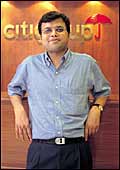 Visiting
Analyst Visiting
Analyst
MADHUSUDAN BAGREE
32
Director,
Citigroup Smith Barney
SECTORS:
Pharma,
FMCG
In the second half of last year,
Madhusudan Bagree, issued a 'sell' call on some large pharma companies.
Their business models were sound, but Bagree believed happenings
in the macro-environment could affect their earnings. His negative
call stood out, but those who heeded his call may find themselves
laughing all the way to the bank now. As Bagree says: ''You have
to look ahead and not generate assumptions based on the past." An
engineer from University of Roorkee and MBA in finance and marketing
from XLRI, Jamshedpur, Bagree started his career at ICICI Securities
in 1996 as a consumer sector analyst and moved to CLSA to track
the pharma sector as well before joining Citigroup Smith Barney
in 2000. Bagree speaks to each of the companies he covers-all the
large pharma and fast moving consumer goods ones and then some-at
least once a week, and visits them every alternate month. For Bagree,
who loves cooking and travelling, things couldn't be better: both
sectors have strong global linkages that often takes him places.
-Roshni Jayakar
His Credit Is
Good
PATHIK GANDOTRA 33
Head
of Research, SSKI
SECTORS:
Banking,
Finance
 If
Pathik Gandotra is considered one of the country's best banking
analysts, he has his seven-year stint at credit rating firm CRISIL-he
was heading the finance sector rating division when he left-to thank
for it. Ergo, by the time he signed on with SSKI, he knew all there
was to know about most Indian banks (30-40) and finance companies
(some 150 of them). "Rating agencies interact closely with banks,"
explains Gandotra. "My CRISIL stint helped me acquire a better perspective
about the banking and finance industry." So, it isn't altogether
surprising that the MBA from MS University, Baroda, was early to
spot the resurgence in India's public sector banks, at a time when
most analysts were not so bullish on the same. One of his recommendations,
Punjab National Bank, for instance, has seen its stock zoom from
Rs 69 in January 2003 to around Rs 330 today. "Management is the
most important factor in banking," he says. And identifying bank
managements with the ability to balance risk and growth, the ultimate
analyst-thing. If
Pathik Gandotra is considered one of the country's best banking
analysts, he has his seven-year stint at credit rating firm CRISIL-he
was heading the finance sector rating division when he left-to thank
for it. Ergo, by the time he signed on with SSKI, he knew all there
was to know about most Indian banks (30-40) and finance companies
(some 150 of them). "Rating agencies interact closely with banks,"
explains Gandotra. "My CRISIL stint helped me acquire a better perspective
about the banking and finance industry." So, it isn't altogether
surprising that the MBA from MS University, Baroda, was early to
spot the resurgence in India's public sector banks, at a time when
most analysts were not so bullish on the same. One of his recommendations,
Punjab National Bank, for instance, has seen its stock zoom from
Rs 69 in January 2003 to around Rs 330 today. "Management is the
most important factor in banking," he says. And identifying bank
managements with the ability to balance risk and growth, the ultimate
analyst-thing.
-Narendra Nathan
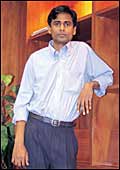 Work
And Play Work
And Play
BHARAT IYER 35
Director,
Citigroup Smith Barney
SECTORS:
Automotive,
Engineering, Capital Goods, Utilities
The twain meet for Bharat Iyer, a
motor sports enthusiast who covers, among other things, the automotive
sector. A MBA from the University of Poona, Iyer came to Smith Barney
from the IIT Investrust (he was with UBS Warburg before that). The
man has his approach planned to a T (he rattles off, for our benefit,
the details he looks for in the auto segment: market potential,
segment-performance, market shares, planned launches, and the like),
talks to each company he covers at least once a month and visits
them thrice a year. With 10 large companies and five small ones
on his radar that leaves him little time to indulge his passions
of tennis and motor sports. Still, he gets to cover auto!
-Roshni Jayakar
The Obsessive
Tracker
ABHAY LAIJAWALA
37
Vice
President, Citigroup Smith Barney
SECTORS:
Cement,
Metals
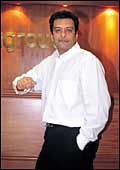 He
makes what he terms "maintenance calls" to the companies he tracks
every week. When there's something brewing the number could go as
high as three calls a day. And he regularly interacts with global
analysts on his beats (especially metals) to extrapolate global
trends to the Indian scenario. Tracking companies isn't just a vocation
for Abhay Laijawala, a MBA from the University of Rhode Island;
it is an obsession. So much so that he will tell you that to be
"first among equals you have got to be on your heels, keep your
ears open so as to get that extra piece of news on the sector or
the company". This analyst has completed the circle: he started
off as an analyst at BZW in 1994 and moved into investment banking
and did time at HSBC and DSP Merrill Lynch before returning to research
at Smith Barney. "To be counted, you have to go that extra mile,"
he says. That, he has. He
makes what he terms "maintenance calls" to the companies he tracks
every week. When there's something brewing the number could go as
high as three calls a day. And he regularly interacts with global
analysts on his beats (especially metals) to extrapolate global
trends to the Indian scenario. Tracking companies isn't just a vocation
for Abhay Laijawala, a MBA from the University of Rhode Island;
it is an obsession. So much so that he will tell you that to be
"first among equals you have got to be on your heels, keep your
ears open so as to get that extra piece of news on the sector or
the company". This analyst has completed the circle: he started
off as an analyst at BZW in 1994 and moved into investment banking
and did time at HSBC and DSP Merrill Lynch before returning to research
at Smith Barney. "To be counted, you have to go that extra mile,"
he says. That, he has.
-Roshni Jayakar
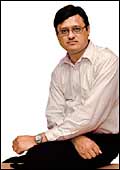 Star
Analyst, Star
Sectors Star
Analyst, Star
Sectors
SANJEEV PRASAD 34
Senior
Analyst, Kotak Securities
SECTORS:
Energy,
Chemicals, Media, Telecommunications
Most analysts would give anything
to be in Sanjeev Prasad's shoes. The IIT-Delhi, IIM-Calcutta alum
has spent the past eight years at Kotak and in association with
analysts from Goldman Sachs (the two firms have an alliance of sorts)
covers the most happening companies in, arguably, the most happening
sectors-Prasad actually heads the investment research teams in the
four sectors named. Prasad's is a numbers-heavy approach: he maps
the strengths and weaknesses of each company within its industry
and predicts future free cash flows, discounts these to arrive at
valuations, and corroborates the result with a cross-country comparison
with similar companies. And "it needs a minimum of 15 per cent upside
from the current price," as he puts it, for him to put out a Buy.
Remember, this is the man who recommended HPCL and BPCL in November
2000 when their scrips were trading at around Rs 100. Today, the
two stocks are quoting at Rs 480-levels. We're all for math-heavy
approaches.
-Narendra Nathan
P for Prozac, P
for Perfect
*MANISH JAIN 33
Senior
Vice President, Research, DSP Merrill Lynch
SECTORS:
Pharmaceuticals,
Healthcare
In 2000, when Dr Reddy's was involved
in litigation with Pfizer over a generic version of the latter's
best-selling anti-depression drug Prozac, the estimated future stock
price numbers on Manish Jain's report were 80 per cent higher than
those on reports issued by other analysts. Jain, reports go, was
sure that Dr Reddy's would win. Win the company did and its stock
shot up over 100 per cent. Jain is said to be of the view that a
good analyst needs to first get his views and perspectives clear.
Part of the India Research team, under Jyoti Jaipuria, which was
rated No. 2 in Institutional Investor's 2003 Asia Research Team
poll, Jain has a MBA in Finance from Narsee Monjee Institute of
Management Studies. And the next time the numbers on his report
are different from that on others, you can bet your bottom dollar
that everyone is going to go by his estimate.
-Abir Pal
Matrix Reloaded
SANJAY CHAWLA 37
Senior
Analyst, Motilal Oswal Securities
SECTORS:
Pharma
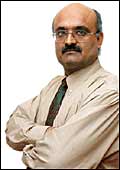 In
early 2003, Sanjay Chawla put out a buy on matrix Laboratories.
The scrip was quoting at Rs 330 then and most analysts believed
it was already over-valued. Chawla didn't think so. He was of the
opinion that investors could benefit from the gap between reality
(the company's fundamentals) and market perception. He was proved
right: the stock trades around Rs 1,440 today. The veteran analyst-the
Master of Management Studies from bits, Pilani, has spent 10 years
in the trade in firms as diverse as IDBI Capital Markets, SMIFS
Securities, and IIT Investrust-is a pharma specialist: his first
major success was his recommendation of Sun Pharma in 1994; the
stock turned out a tenbagger. Right now, Chawla is honing up his
technical analysis skills apart from trying to understand the psychology
of stock trading. In
early 2003, Sanjay Chawla put out a buy on matrix Laboratories.
The scrip was quoting at Rs 330 then and most analysts believed
it was already over-valued. Chawla didn't think so. He was of the
opinion that investors could benefit from the gap between reality
(the company's fundamentals) and market perception. He was proved
right: the stock trades around Rs 1,440 today. The veteran analyst-the
Master of Management Studies from bits, Pilani, has spent 10 years
in the trade in firms as diverse as IDBI Capital Markets, SMIFS
Securities, and IIT Investrust-is a pharma specialist: his first
major success was his recommendation of Sun Pharma in 1994; the
stock turned out a tenbagger. Right now, Chawla is honing up his
technical analysis skills apart from trying to understand the psychology
of stock trading.
-Narendra Nathan
The Quiet
Persuader
JAL IRANI 35
Vice
President, ICICI Securities
SECTORS:
Oil
& Gas, Textiles
Jal Irani was travelling and couldn't
respond to BT's questions. The 11-year veteran of the trade has
covered sectors as diverse as oil & gas, textiles, shipping, fast
moving consumer goods, automotive, steel, power, and shipping in
his career. And one fund manager vouches for Irani's ability at
writing "persuasive" reports.
-Shilpa Nayak
The Fastest
Gun on the Street
*ABHAY SHANBAG NA
NA
HSBC
Securities
SECTOR:
Pharmaceuticals
One fund manager swears by Abhay
Shanbag's speed of coverage. That, his impressive sweep of pharma,
and some sterling recommendations earn him a spot among the best
analysts in the business.
-Shilpa Nayak
Power Broker
*VIDYADHAR GINDE
NA NA
HSBC
Securities
SECTOR:
Energy
Could his be the best hit rate? One
fund manager thinks so and adds that most calls made by Vidyadhar
Ginde in the past 18 months have been right. And others point to
the frequency of his reports (high) as evidence of his continued
and in-depth analysis of the sector.
-Shilpa Nayak
Petrochemical
Predictor
*SONAL JAIN 36
Sr.
Investment Analyst, CLSA
SECTORS:
Fast
Moving Consumer Goods, Petrochemicals
Sonal Jain was among the first to
predict the recent surge in petroleum refining margins. Over the
past couple of years, the MBA from Bombay University has also made
fairly accurate predictions of petrochemical cycles. That's something.
-Narendra Nathan
 Energy-lifer Energy-lifer
SUSANTA MAZUMDAR
35
Director
(Research), UBS Warburg
SECTORS:
Oil
& Gas, Metals, Petrochemicals, Power, Telecommunications
It somehow seems apt that a petroleum
engineer from Dhanbad's Indian School of Mines who started his career
at ONGC ends up as one of India's top energy-sector analysts. That's
the route Susanta Mazumdar, a MBA from IIM-A has taken: engineering
school to business school to ICICI (project finance with an emphasis
on petroleum projects) to equity analysis. Mazumdar, who has been
associated with the Indian energy sector this past 12 years, confesses
that he has a weakness for fundamentals. "What I understand is the
fundamentals of the industry," he says. "And I only concentrate
on it; it is like playing cricket-if one knows batting better, he
should concentrate on it." It is this approach that helped Mazumdar
spot the ONGC Videsh story much before anyone else did. Maybe more
industry-veterans need to get into equity analysis.
-Narendra Nathan
The Value Investor
SRINIVAS RAO RAVURI
31
Senior
Analyst, Motilal Oswal Securities
SECTORS:
Power,
Engineering
 Srinivas
Rao Ravuri is an analyst who fits well into Motilal Oswal's philosophy
of value-investing. And so, the MBA from Hyderabad's Osmania University
starts off his study of companies by meeting people (not just execs
from the company, but others from the industry, including those
in the smallest of firms). Then he sits down, tries to understand
the structural changes in the industry, and uses the discounted
free cash flow approach to arrive at a valuation. "As the value
is linked to the sustainability of earnings growth, the main focus
is to make sure that the company has a sustainable competitive advantage,"
says Rao. The man hit the jackpot with his recommendation of BHEL
(at Rs 150) in October 2001. The power sector was going through
some structural changes and BHEL held a near-monopoly in the supply
of generating equipment, he says, explaining his recommendation.
It all sounds so simple in hindsight but remember, Rao said this
in 2001. Srinivas
Rao Ravuri is an analyst who fits well into Motilal Oswal's philosophy
of value-investing. And so, the MBA from Hyderabad's Osmania University
starts off his study of companies by meeting people (not just execs
from the company, but others from the industry, including those
in the smallest of firms). Then he sits down, tries to understand
the structural changes in the industry, and uses the discounted
free cash flow approach to arrive at a valuation. "As the value
is linked to the sustainability of earnings growth, the main focus
is to make sure that the company has a sustainable competitive advantage,"
says Rao. The man hit the jackpot with his recommendation of BHEL
(at Rs 150) in October 2001. The power sector was going through
some structural changes and BHEL held a near-monopoly in the supply
of generating equipment, he says, explaining his recommendation.
It all sounds so simple in hindsight but remember, Rao said this
in 2001.
-Narendra Nathan
The power Is
With Him
*AJAY SHARMA 28
Senior
Investment Analyst, CLSA
SECTOR:
Pharmaceuticals
This young analyst (just four years
of research experience) came to limelight with his detailed report
on the emergence of Indian pharma companies as a force in the global
generic market titled Attack of the Clones. Not surprisingly, he
has a bachelors degree in pharma in addition to a MBA from IIM-A.
-Narendra Nathan
HOW WE DID IT?
We identified the best analysts by
way of a fund manager survey. We approached the CIO/Head (Equities)
of all big mutual funds (with assets under management exceeding
Rs 1,000 crore) and asked them to nominate five equity analysts
across industries and equity houses. Only analysts with multiple
references were selected. A close look at the winners will reveal
a subtle, but significant trend of industry experts getting into
equity research. Susanta Mazumdar (started his career as an engineer
at ONGC) and C. Visalakshi (started her career as a research scientist
at Cipla) are the best examples of this. P.S: We did try a conventional
scientific approach by requesting all large equity firms to provide
us with all reports published by them in 2003 but this wasn't forthcoming.
The project was coordinated by BT's Chief Analyst Narendra Nathan.
*These five analysts did not speak
to BT for this story
|
